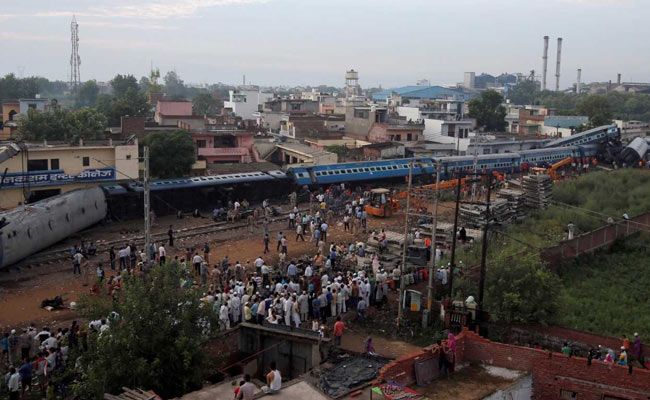
The railway track at Khatauli had developed cracks. It could break any time. The maintenance team from the Engineering Department are aware of it. The maintenance engineer (Permanent Ways Inspector) sought permission from the Station Master for a block of 15-20 minutes for a no-traffic window when they could have cut the damaged portion and repaired it. The station master, after consulting his superiors – section controller – denied the block.
Maintenance Workers Flee on Seeing the Train
The maintenance team then went ahead without permission. They cut the railway line, re-laid the undamaged section of the railway line and started welding the piece.
Before the job was finished, they saw the Kalinga Utkal Express approaching at a speed of 105 km/hour.
The workers fled the scene leaving the work unfinished. They panicked so much that they even left their welding machine and tools on the track.
The facts are slowly emerging of criminal negligence from all quarters that resulted in derailment of the Kalinga Utkal Express in Khatauli.
Saturday, 19 August, will go down in the history of the Indian Railways as the day when everyone knew of the impending disaster, but no one blew the whistle. The audio-recordings and documents that indicate culpability of both the engineering section as well as the operations division of the railways is a clear indication that lethargic staff from various departments contributed for the mishap, and not just engineering department. The Operating Staff also played a role in derailment and cannot go unscathed.
ASM Seeks 20-Minute Window for Repair
In one such recording, Assistant Station Master (ASM) of Khatauli,Prakash Kumar is heard asking Section Controller (SC), PB Taneja – responsible for operations and smooth traffic between Delhi and Saharanpur – that PWI is asking for a 20 minutes ‘block’. The conversation that took place minutes before the mishap goes like this –
SC: Khatauli?
ASM: Sir, the PWI people are asking for a 20-minutes block.
SC: Which block is this now?
ASM: They are saying they have to change something called the glue-joint? But that would bring entire traffic to a halt – main line and loop line, everything will be blocked.
SC: Trains are lined up…
ASM: Yes sir, that is what I have been telling them. Group of trains are coming, how can a block be given to them?
SC: Okay.
In another conversation, the ASM is asking the Section Controller whether he should turn the signal red. SC tells him how can that be allowed as the Utkal Express would then come to a halt. The train has already started moving and should not be stopped at Khatauli.
ASM followed the instructions and it culminated in the mishap which claimed over two dozen lives.
There is yet another conversation that took place a while earlier, in which the ASM is informing the SC of an impending request of PWI for a 15-minutes window to repair the track, but the SC flatly refuses to grant the block as this was a rush hour and a number of trains were moving in that direction.
Unfair to Blame Only the Engineering Division
The matter was, in fact, discussed not only at the junior level – PWI and SM, but at senior levels too. Senior Divisional Manager RK Verma spoke to Divisional Operations/Movements Manager (Delhi), Sudeep Kumar about the cracks in the track at Khatauli.
A day after the accident, station master of Khatauli, Rajendra Singh, in his interviews to newspapers and TV channels, denied knowledge of any ongoing repair on the track.
In any case, when ongoing repair work was common knowledge in Khatauli, Singh feigning ignorance about something that was barely 200 meters from his station and was informed repeatedly about the need for a ‘block’, is simply criminal. A memo was also written by the PWI to SM, Khatauli, Rajendra Singh seeking permission for repairs.
This resulted in the blame being squarely laid on the engineering division and immediate action was initiated against eight officials – right from the PWI to Member (Engineering) of the Railway Board. The operations divisions, however, escaped unscathed. No action was initiated against ASM, SM, SC, Divisional Operations Manager, Chief Operations Manager or Member (Traffic) of Railway Board.
One-Sided Action
It is not that the engineering section is above board. If there were cracks in the track, they shouldn’t have given the go-ahead without permission from the operations division.
Even if they had to go urgently, they should have taken enough precautions to avert the mishap. They should have posted couple of personnel with red flags at least one kilometre ahead of the repair site. This would have either stopped the train or at least would have slowed it down to a manageable speed.
This is the first time top officials like Member, Railway Board, have been taken to task for a train accident. But only one-sided action against the engineering division is causing more than just a few ripples.
